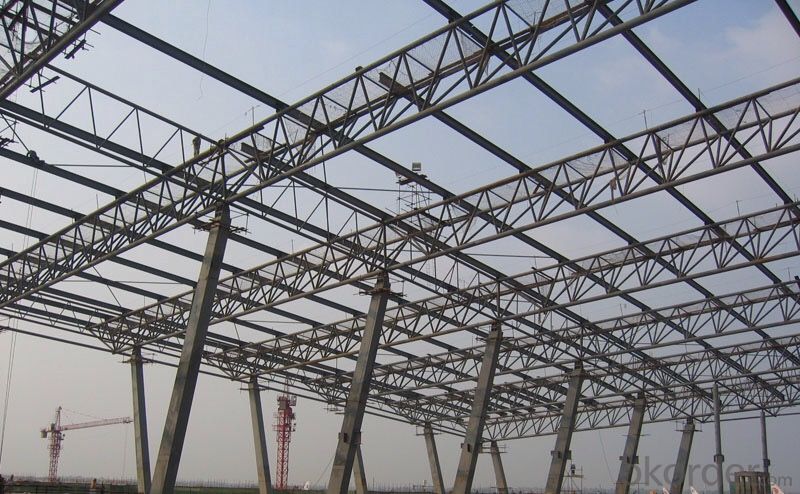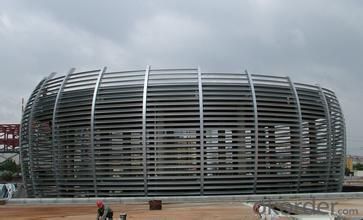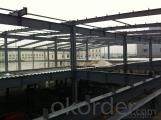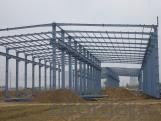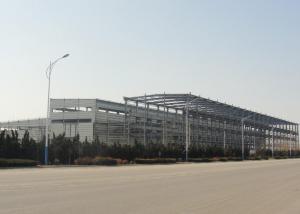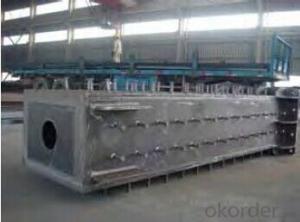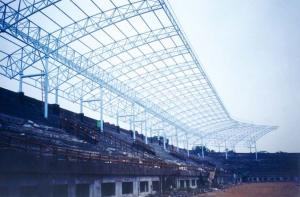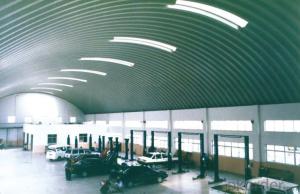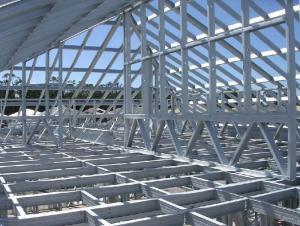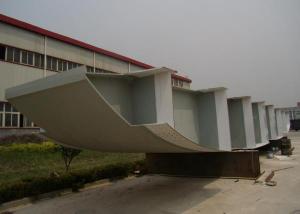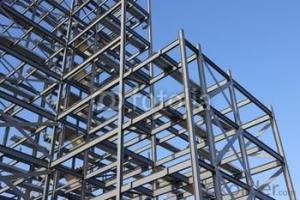Grid Frame Structure Steel Structure
- Loading Port:
- China Main Port
- Payment Terms:
- TT or LC
- Min Order Qty:
- -
- Supply Capability:
- -
OKorder Service Pledge
OKorder Financial Service
You Might Also Like
OKorder is offering Grid frame structure steel structure at great prices with worldwide shipping. Our supplier is a world-class manufacturer of steel, with our products utilized the world over. OKorder annually supplies products to European, North American and Asian markets. We provide quotations within 24 hours of receiving an inquiry and guarantee competitive prices.
Product Applications:
Grid frame structure steel structure are ideal for structural applications and are widely used in the construction of buildings and bridges, and the manufacturing, petrochemical, and transportation industries.
Product Advantages:
Grid frame structure steel structure are durable, strong, and resist corrosion.
Main Product Features:
· Premium quality
· Prompt delivery & seaworthy packing (30 days after receiving deposit)
· Corrosion resistance
· Professional Service
· Competitive pricing
Product Specifications:
Specifications
1) . Easy to install, fire proof, good insulation
2). Certification: ISO9001:2000, SGS Standard.
Steel Structure Warehouse:
1.The steel structure of the connection method: welding connection
2.Steel structure design common norms are as follows: "Steel Design Code" (GB50017-2003) Cold-formed steel structure technical specifications" (GB50018-2002) "Construction Quality Acceptance of Steel" (GB50205-2001) "Technical Specification for welded steel structure" (JGJ81-2002, J218-2002) "Technical Specification for Steel Structures of Tall Buildings" (JGJ99-98)
3.The characteristics of steel Light weight steel structure Higher reliability of steel work Steel anti-vibration (earthquake), impact and good Steel structure for a higher degree of industrialization Steel can be assembled quickly and accurately Large steel interior space Likely to cause sealing structure Steel corrosive Poor fire-resistant steel Recyclable steel shorter duration
4.Commonly used steel grades and performance of steel Carbon
structural steel: Q195, Q215, Q235, Q255, Q275, etc.
High-strength low-alloy structural steel Quality carbon structural steel and alloy structural steel Special purpose steel Product Feature Carport, House, Office, Shop, Toilet, Villa, Warehouse, Workshop, Plant Other Information
Products have been all over the country more than 20 provinces, municipalities and autonomous regions, and have been exported to Europe, North America, the Middle East, Africa, Asia and other countries and regions, the widespread use
FAQ:
Q1: Why buy Materials & Equipment from OKorder.com?
A1: All products offered byOKorder.com are carefully selected from China's most reliable manufacturing enterprises. Through its ISO certifications, OKorder.com adheres to the highest standards and a commitment to supply chain safety and customer satisfaction.
Q2: How do we guarantee the quality of our products?
A2: We have established an advanced quality management system which conducts strict quality tests at every step, from raw materials to the final product. At the same time, we provide extensive follow-up service assurances as required.
Q3: How soon can we receive the product after purchase?
A3: Within three days of placing an order, we will begin production. The specific shipping date is dependent upon international and government factors, but is typically 7 to 10 workdays.
Images:

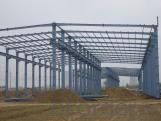
- Q: What are the different types of architectural finishes used in steel structures?
- Some common types of architectural finishes used in steel structures include paint coatings, galvanization, powder coating, and cladding materials such as aluminum or glass. These finishes not only enhance the aesthetic appeal of the structure but also provide protection against corrosion and weathering.
- Q: How do steel structures perform in terms of natural lighting?
- Steel structures typically perform well in terms of natural lighting. The use of steel allows for the incorporation of large windows and open spaces, which allow ample natural light to enter the building. Additionally, steel structures can be designed to have high ceilings and open floor plans, further enhancing natural lighting throughout the space.
- Q: What are the different types of steel roof systems?
- There are various types of steel roof systems available, including standing seam roofs, corrugated roofs, and metal shingles.
- Q: What are the design considerations for steel canopies and shade sails?
- When designing steel canopies and shade sails, there are several important considerations to take into account. Firstly, the structural integrity of the canopy or sail must be carefully considered. Steel canopies and shade sails are typically exposed to various weather conditions, such as wind, rain, and snow. Therefore, the design must be able to withstand these elements and ensure the safety of the users underneath. The structure should be able to resist wind loads and prevent any potential collapse or damage. Secondly, the design should take into account the intended purpose and location of the canopy or sail. If it is meant to provide shade in a sunny area, the design should ensure adequate coverage and protection from harmful UV rays. Additionally, if the canopy or sail is meant to provide shelter in a rainy area, the design should consider proper drainage and waterproofing to prevent water accumulation and leakage. Another important consideration is the aesthetic appeal of the design. Canopies and shade sails often serve as architectural elements and should complement the overall design of the surrounding space. The shape, color, and materials used should be chosen in a way that enhances the visual appeal of the structure and blends well with the surrounding environment. Furthermore, the ease of installation and maintenance should also be considered during the design process. Steel canopies and shade sails should be designed in a way that allows for easy installation, dismantling, and relocation if necessary. The choice of materials and construction methods should also ensure durability and minimize the need for frequent maintenance. Lastly, budget constraints and sustainability should be taken into account. The design should be cost-effective and efficient, using materials and techniques that are environmentally friendly and sustainable. This could include utilizing recycled materials or incorporating renewable energy sources into the design. In conclusion, when designing steel canopies and shade sails, it is crucial to consider factors such as structural integrity, purpose and location, aesthetics, ease of installation and maintenance, and budget and sustainability. By carefully considering these design considerations, a functional, aesthetically pleasing, and durable canopy or shade sail can be created.
- Q: How are steel structures used in the construction of hospitals and healthcare facilities?
- Steel structures are commonly used in the construction of hospitals and healthcare facilities due to their strength, durability, and flexibility. They provide a sturdy framework, allowing for large open spaces, which can accommodate various medical equipment, machinery, and infrastructure requirements. Steel structures also offer resistance to fire, earthquakes, and other natural hazards, ensuring the safety of patients and staff. Additionally, steel can be easily modified or expanded, facilitating future renovations or additions to the healthcare facility.
- Q: What are the design considerations for steel commercial buildings?
- When designing steel commercial buildings, it is important to take into account various factors such as structural integrity, aesthetics, functionality, sustainability, and cost-effectiveness. Structural integrity is a crucial aspect to consider when designing steel commercial buildings. These structures must be able to withstand different types of loads, including wind, snow, and seismic forces. Steel structures are known for their strength and durability, making them an ideal choice for commercial buildings that require large open spaces and flexible layouts. Aesthetics also play a significant role in commercial buildings, as they often serve as a representation of the business or brand. Steel structures offer versatility in design, allowing for unique architectural features and creative façade options. The use of steel also allows for the incorporation of large windows and open spaces, creating an inviting and visually appealing environment. Functionality is another important consideration in commercial building design. The layout and design should optimize the functionality of the space and meet the specific needs of the business. Steel structures provide column-free spaces, offering flexibility for interior layouts and efficient utilization of floor space. This flexibility also allows for future expansions or modifications to the building. Sustainability is an increasingly important aspect in building design. Steel is a highly sustainable material, as it can be 100% recycled and reused without losing its properties. Moreover, steel structures can incorporate energy-efficient features, such as insulation, solar panels, and efficient HVAC systems, reducing the environmental impact of the building. Cost-effectiveness is a significant consideration for commercial buildings. Steel structures are usually quicker to construct compared to traditional building materials, resulting in reduced labor costs and minimal disruption to business operations. The durability and low maintenance requirements of steel buildings also contribute to long-term cost savings. In conclusion, the design considerations for steel commercial buildings encompass structural integrity, aesthetics, functionality, sustainability, and cost-effectiveness. By carefully taking these factors into account, architects and engineers can create efficient, visually appealing, and sustainable commercial buildings that meet the specific needs of businesses.
- Q: What are the key differences between a steel-framed building and a steel truss structure?
- The key differences between a steel-framed building and a steel truss structure lie in their structural design and purpose. A steel-framed building utilizes a framework made of steel columns and beams to support the vertical and horizontal loads of the structure. It is commonly used for commercial and residential buildings, offering flexibility in architectural design and easier integration of other materials. On the other hand, a steel truss structure employs a system of interconnected steel trusses to distribute the loads evenly across the span or length of the structure. Trusses are typically triangular in shape and provide efficient load-bearing capabilities, making them ideal for large spans such as bridges, roofs, and industrial structures. They are often pre-fabricated and assembled on-site, allowing for faster and cost-effective construction. In summary, while both steel-framed buildings and steel truss structures utilize steel as the primary material, their main differences lie in their design concept, purpose, and application.
- Q: How do steel structures handle differential settlement?
- Steel structures are designed to handle differential settlement through a combination of flexible connections, adjustable supports, and careful consideration of the foundation design. The inherent strength and flexibility of steel allows it to accommodate differential settlement by redistributing the loads and minimizing stress concentrations. Additionally, steel structures can be easily modified and adjusted to match the settlement patterns, ensuring their stability and longevity.
- Q: How are steel structures used in the construction of industrial buildings?
- Steel structures are commonly used in the construction of industrial buildings due to their numerous benefits and advantages. Steel is a highly durable and strong material, making it ideal for supporting heavy loads and withstanding harsh weather conditions. One of the key ways steel structures are used in the construction of industrial buildings is for the framework or skeleton of the building. Steel beams and columns are used to create a sturdy and reliable structure that can support the weight of the entire building. This allows for larger and more open spaces within the building, providing flexibility for various industrial operations and equipment. Steel structures also offer great versatility in design and construction. They can be easily customized to meet specific requirements and can accommodate various architectural styles. This flexibility allows for the creation of complex and unique industrial buildings that are tailored to the specific needs of the industry or company. Furthermore, steel structures are cost-effective and time-efficient. Steel components are typically prefabricated offsite, which reduces construction time and labor costs. The ease of assembly and installation of steel components also contribute to faster construction timelines, allowing industrial buildings to be completed in a shorter period of time compared to traditional construction methods. Steel structures also have excellent fire resistance, which is crucial for industrial buildings. Steel does not burn, melt, or contribute to the spread of fire, making it a safe choice for industrial environments. Additionally, steel structures are resistant to pests, such as termites, which can be a common issue in conventional building materials. In summary, steel structures are widely used in the construction of industrial buildings due to their durability, strength, versatility, cost-effectiveness, and fire resistance. They provide a solid framework for industrial operations and offer flexibility in design. Ultimately, steel structures contribute to the creation of safe, efficient, and functional industrial buildings.
- Q: How are steel foundations designed and installed?
- To ensure the stability and durability of structures, a systematic approach is used in the design and installation of steel foundations. This involves several steps. Initially, the design stage begins with a thorough analysis of the site conditions, including soil type, load requirements, and any potential environmental factors. This information is crucial in determining the appropriate size and shape of the steel foundation. Subsequently, engineers utilize this data to create a detailed design plan. They take into account factors such as the weight of the structure, the anticipated loads it will bear, and any lateral forces that may be exerted on it. By using specialized software and calculations, they determine the necessary dimensions and specifications for the steel foundation. Once the design is finalized, the fabrication of the steel foundation commences. This involves cutting and shaping the steel components according to the design specifications. To prevent corrosion and increase its lifespan, the steel is often coated with protective layers, such as galvanization. Following the fabrication process, the steel foundation is installed. The site is prepared by excavating the ground and creating a level surface for the foundation. Depending on the design, concrete footings or piers may be required to provide additional support. Careful positioning and securing of the steel foundation then take place. This may involve welding or bolting the steel components together. Precision and accuracy are crucial during this stage to ensure proper alignment and levelness. After installation, the steel foundation undergoes inspection to ensure it meets the required standards and specifications. Any necessary adjustments or modifications are made to ensure stability and safety. Overall, the design and installation of steel foundations encompass a comprehensive approach that considers site conditions, load requirements, and structural integrity. By following this process, steel foundations offer a dependable and long-lasting solution for supporting a wide range of structures.
Send your message to us
Grid Frame Structure Steel Structure
- Loading Port:
- China Main Port
- Payment Terms:
- TT or LC
- Min Order Qty:
- -
- Supply Capability:
- -
OKorder Service Pledge
OKorder Financial Service
Similar products
Hot products
Hot Searches
Related keywords





